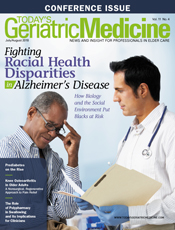
July/August 2018
Vintage Voices: Neuroplasticity and Dysphagia Our understanding of the organization and workings of the cerebral cortex has changed in recent years. It's now known that the brain is able to adapt to environmental challenges and functional disabilities caused by cortical lesions including infarction, hemorrhage, and trauma. Neuroplasticity is the process of functional alteration of neural substrates to produce an adaptive behavior in response to an event adverse to synaptic function.1-4 The capability of the brain to compensate for cortical deficits via adaptive changes to synaptic networks directly affects the patient's ability to recover from injury, acquire new information, and adapt to a rapidly changing environment.2,3,5,6 Principles of Neuroplasticity • Use It or Lose It: If a neural substrate is not biologically active, its function can degrade. • Use It and Improve It: Increased biological activity enhances future functioning, especially if that activity involves skill training or targeted practice. • Plasticity Is Experience Specific: Changes only occur in the neural substrates involved in the particular behavior being trained.5 • Repetition Matters: Neural substrates may be modified by extensive and prolonged practice, and repetition has been shown to be important for producing brain changes and the ability to maintain these changes. • Intensity Matters: The intensity of stimulation influences the degree of neural plasticity. • Time Matters: Longer and continuous periods of training can maximize neural change.6 • Salience Matters: Neural plasticity is best induced when the movement being targeted is purposeful and related to the behavior being trained.8-10 • Age Matters: Neural plasticity occurs across the life span, with the degree of plasticity decreasing with age. • Transference: Plasticity within one set of neural circuits may promote concurrent or subsequent plasticity in other related cortical areas.7 • Interference: Plasticity within a given neural circuit has the ability to impede the induction of new, or expression of existing, plasticity within the same circuitry.7 Role in Dysphagia The principles of neuroplasticity offer a theoretical and a practical framework to treatment parameters for dysphagia rehabilitation.1 It's essential for clinicians to understand how neuroplasticity affects learning across the life span, to know how to take advantage of the brain's plastic nature when planning dysphagia treatment, and to recognize the effect of neural changes on swallowing function when directly treating patients with dysphagia. Investigations into the role of neuroplasticity in the treatment of dysphagia have begun to emerge in the literature. Treatment protocols based on the principles of neuroplasticity that target cortical reorganization have potential for positive outcomes, most notably in patients with cortical lesions. Continued clinical research studies and large-scale clinical treatment trials are needed to confirm efficacy of such treatment protocols. — Jennifer M. Pusins, CScD, CCC-SLP, IBCLC, is an assistant professor at Nova Southeastern University. Her area of clinical expertise is in the assessment and management of dysphagia across the life span. She has presented at the state, national, and international levels on various topics related to dysphagia. References 2. Tinazzi M, Zanette G, Volpato D, et al. Neurophysiological evidence of neuroplasticity at multiple levels of the somatosensory system in patients with carpal tunnel syndrome. Brain. 1998;121(9):1785-1794. 3. Urasaki E, Genmoto T, Wada S, Yokota A, Akamatsu N. Dynamic changes in area 1 somatosensory cortex during transient sensory deprivation. J Clin Neurophysiol. 2002;19(3):219-231. 4. Ziemann U, Hallett M, Cohen LG. Mechanisms of deafferentation-induced plasticity in human motor cortex. J Neurosci. 1998;18(17):7000-7007. 5. Kleim J, Barbay S, Cooper N, et al. Motor learning-dependent synaptogenesis is localized to functionally reorganized motor cortex. Neurobiol Learn Mem. 2002;77(1):63-77. 6. Fisher B, Sullivan K. Activity-dependent factors affecting poststroke functional outcomes. Top Stroke Rehabil. 2001;8(3):31-44. 7. Kleim J, Jones T. Principles of experience-dependent neural plasticity: implications for rehabilitation after brain damage. J Speech Lang Hear Res. 2008;51(1):S225-239. 8. Morgen K, Kadom N, Sawaki L, et al. Kinematic specificity of cortical reorganization associated with motor training. NeuroImage. 2004;21(3):1182-1187. 9. Plautz E, Milliken G, Nudo R. Effects of repetitive motor training on movement representations in adult squirrel monkeys: role of use versus learning. Neurobiol Learn Mem. 2000;74(1):27-55. 10. Remple MS, Bruneau RM, VandenBerg PM, Goertzen C, Kleim JA. Sensitivity of cortical movement representations to motor experience: evidence that skill learning but not strength training induces cortical reorganization. Behav Brain Res. 2001;123(2):133-141. 11. Logemann J. Evaluation and Treatment of Swallowing Disorders. 2nd ed. Austin, TX: Pro-Ed; 1998:1-3. |
